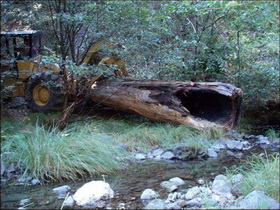NOAA Habitat
NOAAHabitat
Pacific salmon and trout in northern California have declined rapidly since the mid-1900s. Part of the decline was due to historic logging industry practices. Logging companies harvested streamside trees and left wood clogging creeks. This debris mingled with fallen trees in the creeks, creating fish migration barriers and causing flooding. So many local agencies removed all the wood—seems like the obvious solution, right?
See the dozens of unique artificial fish habitat models, fish attractors and fish cover used at fishiding.com, the leader in science based, proven, fish protection.
But this solution produced another problem. Fish like endangered coho salmon need streams and rivers to have both slow and fast currents—they rest and grow in the slow currents, and breed in the faster water. Logs and other natural woody debris help slow the flow of water in parts of creeks and rivers, providing habitat for the fish. With all the wood removed, little impeded the water; it sluiced through creeks and rivers, and the fish had much less of the habitat they needed to survive. As a result of this and other factors, salmon populations declined rapidly.
With funding from the NOAA Restoration Center, The Nature Conservancy and the Conservation Fund are taking a unique approach for environmental groups: they are cutting down trees and strategically placing them in tributaries of the Garcia River in Mendocino County.
Traditional, salmon habitat restoration projects using wood were engineered and anchored in place, but that method can be expensive and time intensive. Our partners collaborated with the NOAA Restoration Center and others to test an innovative approach. We let stream flow move and place the wood, forming natural log jams that slow the water—creating critical habitat that fish need to survive.
These projects cost one-third or less than traditional methods, and allow restoration over much larger areas than before.
Posted February 6, 2012




